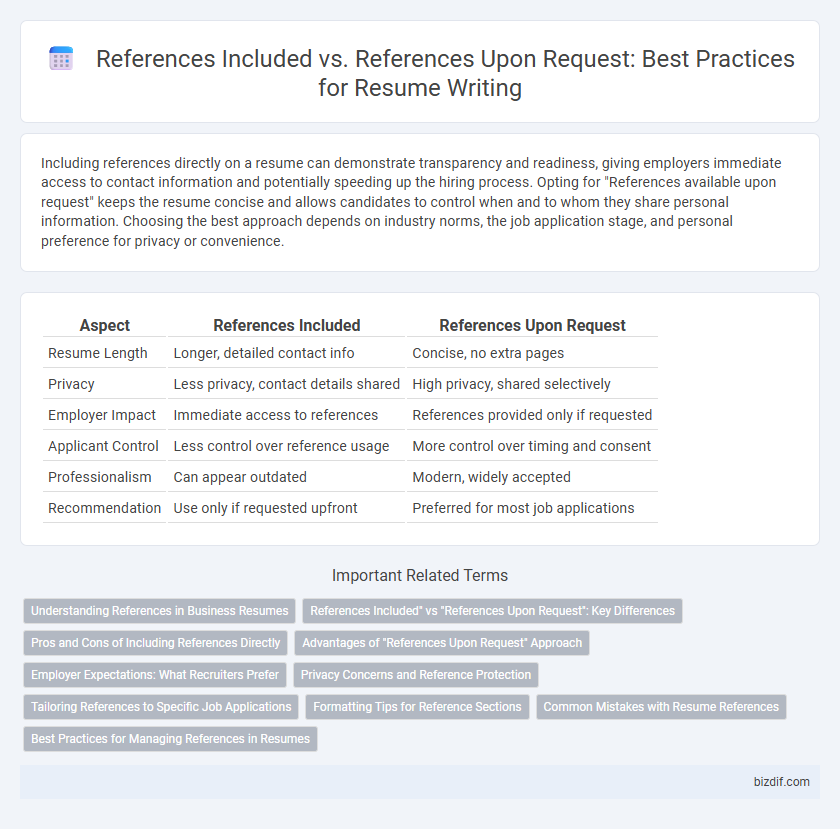Including references directly on a resume can demonstrate transparency and readiness, giving employers immediate access to contact information and potentially speeding up the hiring process. Opting for "References available upon request" keeps the resume concise and allows candidates to control when and to whom they share personal information. Choosing the best approach depends on industry norms, the job application stage, and personal preference for privacy or convenience.
Table of Comparison
| Aspect | References Included | References Upon Request |
|---|---|---|
| Resume Length | Longer, detailed contact info | Concise, no extra pages |
| Privacy | Less privacy, contact details shared | High privacy, shared selectively |
| Employer Impact | Immediate access to references | References provided only if requested |
| Applicant Control | Less control over reference usage | More control over timing and consent |
| Professionalism | Can appear outdated | Modern, widely accepted |
| Recommendation | Use only if requested upfront | Preferred for most job applications |
Understanding References in Business Resumes
Including references directly on a business resume can demonstrate transparency and readiness, showcasing credible contacts who can vouch for professional skills and achievements. However, many experts recommend stating "References Upon Request" to save space and control when and to whom references are shared, maintaining confidentiality. Understanding when to include references depends on the industry expectations, the job level, and the strength of your professional network's endorsements.
References Included" vs "References Upon Request": Key Differences
Listing "References Included" on a resume signals readiness to provide contact information immediately, enhancing credibility and transparency for potential employers. In contrast, "References Upon Request" keeps references private until requested, maintaining resume brevity but potentially delaying background checks. Choosing between these approaches depends on industry norms and the job seeker's confidence in their professional endorsements.
Pros and Cons of Including References Directly
Including references directly in a resume increases transparency and allows employers immediate access to credible endorsements, potentially speeding up the hiring process. This approach can demonstrate confidence and preparedness but may also result in privacy concerns for references and reduce control over when references are contacted. Conversely, listing references upon request preserves privacy and allows candidates to tailor references to specific job applications, but it can delay the verification stage and reduce initial impact.
Advantages of "References Upon Request" Approach
Choosing "References Upon Request" in a resume helps maintain privacy and control over personal contact information of referees, preventing unsolicited communication. This approach also allows candidates to tailor references to specific job roles, ensuring relevancy and stronger endorsements. Employers appreciate the flexibility as it streamlines the initial resume review process, focusing attention on skills and experience first.
Employer Expectations: What Recruiters Prefer
Employers increasingly expect resumes to state "References Upon Request" rather than listing references directly, as this approach streamlines the initial screening process and protects candidates' privacy. Recruiters prioritize concise, focused resumes that highlight skills and experience while leaving reference verification for later stages. Including references prematurely may be seen as outdated and can clutter the resume, reducing its semantic relevance to job requirements.
Privacy Concerns and Reference Protection
Including references directly on a resume can expose personal contact information, raising privacy concerns for both the applicant and their references. Opting for "References Available Upon Request" protects the confidentiality of references by sharing their details only when necessary and with trusted parties. This approach minimizes unsolicited contact and maintains the integrity and privacy of valuable professional connections.
Tailoring References to Specific Job Applications
Including tailored references directly on a resume can strengthen job applications by showcasing relevant professional contacts that align with the specific role and industry. Providing references upon request allows candidates to customize their selection based on the employer's preferences, ensuring the most pertinent and impactful endorsements are shared. Strategic reference management enhances credibility and demonstrates attention to detail, significantly improving hiring prospects.
Formatting Tips for Reference Sections
Including references directly in a resume requires a dedicated section with clear headings, consistent font styles, and aligned contact details to ensure readability and professionalism. When opting for "References Upon Request," guidelines suggest omitting the section altogether to save space and maintain a clean layout, while preparing a separate, well-formatted reference list with full names, titles, relationships, and up-to-date contact information for easy sharing. Proper formatting emphasizes clarity, such as using bullet points or tables to organize entries, ensuring phone numbers and email addresses are easy to locate, and avoiding clutter by limiting each reference to essential details.
Common Mistakes with Resume References
Including "References Included" on a resume can take up valuable space without adding meaningful value, while "References Upon Request" leaves hiring managers uncertain about your preparedness. Common mistakes include listing outdated or unprofessional contacts and failing to inform references in advance, which can lead to delayed or negative feedback. Optimizing your resume by omitting these phrases and providing references only when requested ensures a streamlined, professional presentation.
Best Practices for Managing References in Resumes
Including references directly on a resume can consume valuable space and may expose personal contact details prematurely, whereas stating "References available upon request" allows candidates to maintain privacy and provide tailored references when sought by employers. Best practices recommend preparing a separate reference list with up-to-date contact information and professional titles to share only when requested, ensuring relevance and readiness. Strategically managing references enhances professionalism and streamlines the hiring process by demonstrating respect for both recruiter time and candidate confidentiality.
References Included vs References Upon Request Infographic

 bizdif.com
bizdif.com